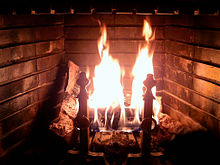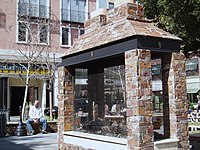Fireplace
| | This article does not cite any references or sources. Please help improve this article by adding citations to reliable sources. Unsourced material may be challenged and removed. (May 2008) |
| It has been suggested that this article or section be merged into Hearth. (Discuss) |
A fireplace is an architectural structure to contain a fire for heating and, especially historically, for cooking. A fire is contained in a firebox or firepit; a chimney or other flue directs gas and particulate exhaust to escape. Fireplaces are a central household feature, as the flames and crackling sounds are comforting, even when not necessary for heat or cooking. Fireplace mantels are a focus for interior decoration.
Contents[hide] |
[edit] Types of fireplace
A fireplace may have: a foundation, a hearth, a firebox, a fireplace mantel, an ashdump door, a chimney crane, a cleanout door, a grate, a lintel, a lintel bar, overmantel, a chimney breast, a damper, a smoke chamber, a throat, a flue, a chimney chase, a crown, a cap, a shroud, or a spark arrestor.
Fireplace types:
- Masonry (brick or stone fireplaces and chimneys.
- Manufactured ("prefab") fireplaces with sheet metal fire boxes.
Masonry and prefab fireplaces can be fueled with wood, natural gas, biomass and lp/propane fuel sources.
- Ventless Fireplaces (duct free/room-venting fireplaces) that are fueled by either gel, LP/bottled gas or natural gas. In the US, some states and local counties have laws and ordinances regarding these types of fireplaces. They require the least installation and are the most efficient fireplace. The gas burning version of a vent free fireplace while using less fuel, burns that fuel at close to 100% efficiency. They must be sized appropriately to the area to be heated. Aside from the heat output there are also air quality control problems due to the amount of moisture they release into the room air, and oxygen sensor and carbon monoxide sensors are safety essentials.
Chimney/flue types:
- Masonry (brick or stone fireplaces and chimneys) with or without tile lined flue.
- Reinforced concrete chimneys. Fundamental flaws (the difference in thermal expansion rates between steel rebar and concrete which caused the chimney flues to crack when heated) bankrupted the US manufacturers and obsoleted the technique. This is evidenced by vertical cracks on the exterior of the chimney.
- Metal-lined flue: Double or triple walled metal pipe running up inside a new or existing wood framed or masonry chase
Newly constructed flues may feature a chase cover, a cap, and a spark arrestor at the top to keep small animals out and sparks from exiting the chimney cavity.
[edit] History
Ancient fire pits were sometimes built in the ground in the center of a hut or dwelling. Smoke escaped through holes in the roof. Smoke would be blown outside or back into the room. Chimneys, invented much later, partially fixed this problem, venting smoke outside.
In 1678 Prince Rupert, nephew of Charles I, raised the grate of the fireplace, improving the airflow and venting system. The 18th century saw two important developments in the history of fireplaces. Ben Franklin developed a convection chamber for the fireplace that greatly improved the efficiency of fireplaces and wood stoves. He also improved the airflow by pulling air from a basement and venting out a longer area at the top. In the later 18th century, Count Rumford designed a fireplace with a tall, shallow firebox that was better at drawing the smoke up and out of the building. The shallow design also improved greatly the amount of radiant heat projected into the room. Rumford's design is the foundation for modern fireplaces.
One famous tradition in the United States during the Great Depression was President Franklin Delano Roosevelt's "fireside chats", weekly radio addresses in which he made use of the family gathering time to state his views.
Many homes no longer have open fireplaces, they are often replaced by what is considered to be more efficient ways of heating, such as central heating, or electric heaters. The social function of the fireplace is often substituted by the home entertainment center. Some fireplaces have been closed off not allowing them to be used. Some have been made unable to be used by feeding a telephone, television antenna, cable TV or satellite TV wire down them. For homeowners that want the ambiance of a fireplace without the fire, there are several alternatives. One is to install a 'fake fire' or gas fireplace, which offers the fireplace effect. For people with existing fireplaces, the alternative to simply closing them up is to install a gas, wood or biomass fireplace insert. Some governments have a partial ban on solid fuel burning fireplaces due to air pollution. Ventless fireplaces have received attention recently: they are free standing, requiring no chimney and no hearth. Prefabricated fireplaces are popular because of their lower construction cost and some considered them to be safer and more reliable. Brick or stone fireplaces can be designed to meet exact specifications for opening size, depth, and facing material. The open brick or stone fireplaces can cost more to build and usually require regular cleaning or maintenance.
[edit] Heating efficacy
The heating effect of a fireplace is largely due to radiative heating, by which objects surrounding the fireplace are heated up, and some of this heat is transferred to the air. It is a common misconception that a fireplace leads to energy savings by reducing the heating load on a home. In fact, a fireplace moves large amounts of air out of the home which must be replaced by outside air.[1] The outside air, presumably at a lower temperature, must be heated by the home's HVAC system. Some fireplace units incorporate a blower which aims to transfer more of the fireplace's heat to the air via convection, resulting in a more homogenously heated space and a lower heating load.
[edit] Accessories
A wide range of accessories are used with fireplaces, which vary between countries and regions, and historical periods. For the interior, common in recent Western cultures are grates, fireguards, logboxes, andirons, pellet baskets, and fire dogs, all of which cradle fuel and accelerate burning. Heavy metal firebacks are sometimes used to capture and reradiate heat, to protect the back of the fireplace, and as decoration.
In the last several decades tubular grate heaters have become an increasingly popular accessory to significantly increase the efficiency of a fireplace and hence the amount of heat that makes it from the fireplace out into the home. They work by having a naturally convected or fan forced tubular metal heat exchanger that is heated by the coals and or fire. They draw in cold air from the floor and blow heated air back out into your home. This adds an element of conductive and convective heating to the radiant heat typical of a basic fireplace. Grate Heaters have been called many things; heatilator, hearth heater, fireplace blower, fireplace grate heater, etc...
For fireplace tending, tools include pokers, bellows, tongs, shovels, brushes and toolstands.



